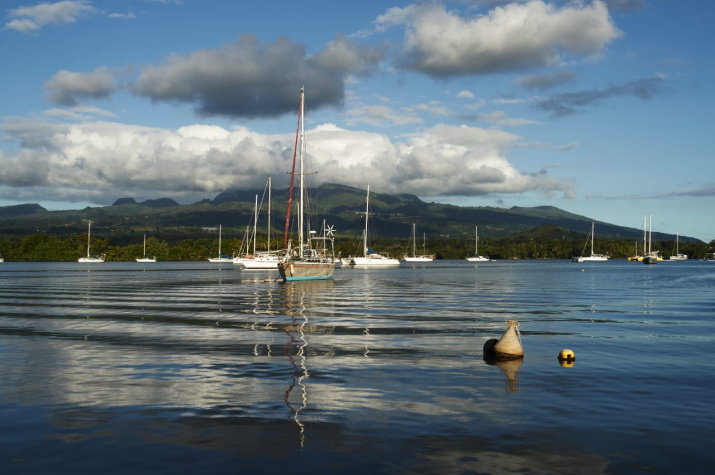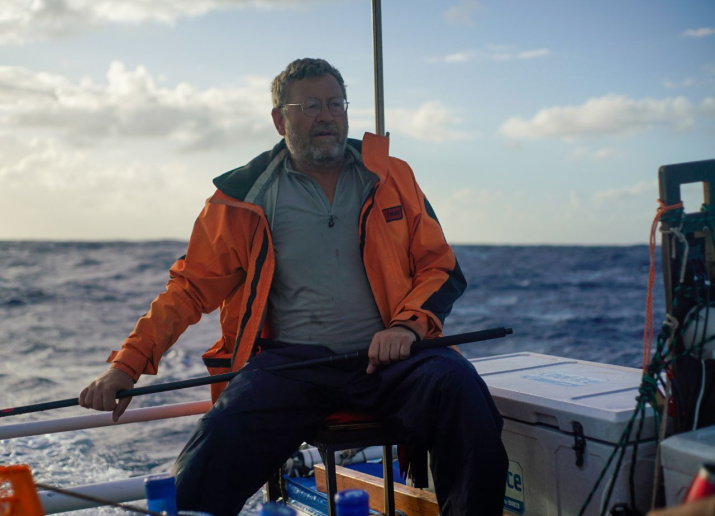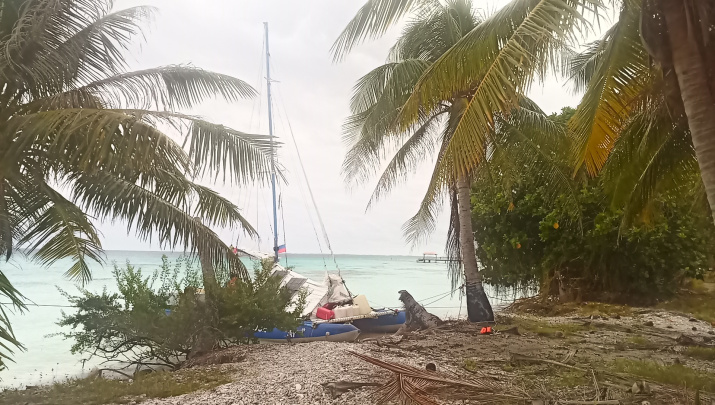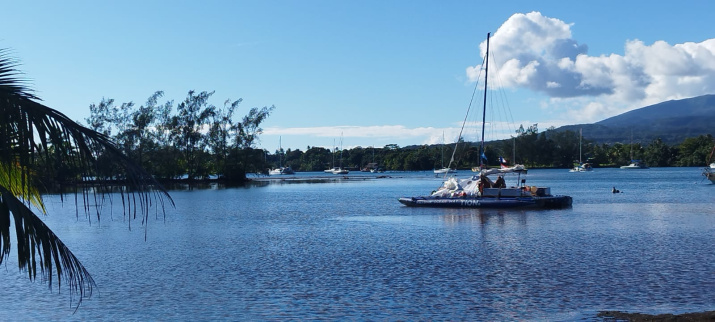Early on the morning of June 5, the catamaran of the circumnavigation expedition of the Tomsk Regional Branch of the Russian Geographical Society anchored in the bay of Tahiti, the main island of French Polynesia. Travelling here from the Gambier Islands in the southeastern part of the Tuamotu took Evgeny Kovalevsky, Stanislav Berezkin, Andrey Cherepanov, and Caleb Jara Garate 20 days. These nearly three weeks were full of work and adventure: the vessel was attacked by a shark, the crew struggled with the weather, and breakdowns, solved problems, found traces of Russian circumnavigators, and made new friends.
The circumnavigators left the island of Mangareva of the Gambier Islands on May 17. Almost immediately, it became clear from the weather that the catamaran had fallen into the influence zone of the natural phenomenon of El Niño. It is one of the phases of the so-called Southern Oscillation – a phenomenon that has a significant impact on the Earth's climate. When it occurs, the area of heated near surface waters shifts to the east, weakening or even "stopping" the trade winds, which blow from the tropics all year round in the direction of the equator. At the same time, upwelling – the rise of deep waters to the surface – is also weakening in the eastern Pacific Ocean.
“Because of this, instead of constantly blowing south-east trade winds, we got a ‘weather mess.’ Had to spend a week on the island of Mangareva, and then headlong rush to the north-west, hoping to outrun the rising atmospheric vortices. Fortunately, the trajectories of vortices are possible to guess. But this is not always the case,” said the captain of the catamaran Stanislav Berezkin.
The crew had two options for starting the voyage: to go 220 miles straight to the island of Nukutavake with a tiny harbor and without communication, or to try to reach the 18°N, the atoll of Hao halfway to Tahiti.
“The second option was preferable, but Hao was 350 miles away in a straight line and it was not clear how far away it was not in a straight line. Still, we decided to take the risk,” explained Berezkin.
The first two days there was light south-east wind. The catamaran Russian Ocean Way – Tion, it seemed, for the first time in its life, was going full sail. By evening of the second day the circumnavigation reached Marutea Atoll. It was here that, according to the forecast, the weather was supposed to get capricious.
“The wind died down, it got cloudy; it took us several hours to bypass the atoll. A squall – not strong, but frightening – started blowing as the night fell. First, a little cloud formed on the right; in 15 minutes it turned into a sprawling monster that was trying to reach ahead of our course with its hand. But you ain't gonna get us! We're going to make it, and you will dissipate and rain behind our vessel. When this happens, it's hard to resist and not stick your tongue out at the disappearing cloud,” confessed Berezkin.
There are several stressful situations along the way. Hao was approached two hours before dawn with a disgusting forecast: a strong north-westerly wind was expected to rise any minute.
“And we were fully exposed. I tried to lower the rpms, but the throttle lever did nothing. Out of habit, I turned the handle left and right, but there were a lot of rpms. And suddenly, the tackle of the vessel’s motor breaks and the motor with a joyful roar flies under the deck. At the last moment I manage to pull the pin and kill the engine. Not enough wind, too much waves, the catamaran is sailing straight in the direction of the reef near the atoll. Luckily, it was about six miles away – a couple of knots, we still had time,” said Berezkin.
The travelers had to go on a real quest in a hurry. They removed the life raft and even cut the deck.
“Out with the old tackle, used a new one – it doesn’t lift . Took the rope out, put it back again. Hooray, it worked! Start, motor is roaring at full throttle, take off the hood, move the throttle lever, speed is normal. Put the hood back, let's go!” said Stanislav Berezkin.
Before the circumnavigators entered the lagoon, a huge whale waved at the them with its tail against the dawn. A good sign!
“Moored at an abandoned military base, and half an hour later came the cyclone. But I stuck my tongue out at it: didn’t catch us, didn’t catch us!” joked Berezkin.
Hao with its lagoon, one of the largest in French Polynesia, is a quite famous place. In the early 1960s, advanced for that period infrastructure appeared here: an airport, a 15km long road, houses, tanks for fresh water, laboratories, and more. The reason for the construction was nuclear weapons tests by France. The Center for Nuclear Explosions Monitoring was demolished relatively recently – in 1998.
“Right now we are on the territory of that base. The former nuclear test sites on the atolls of Moruroa and Fangataufa are about 250 nautical miles away. It will take our catamaran little more than two days to get there,” said the lead scientist of the expedition, Evgeny Kovalevsky.
Nowadays, no more than 1,000 people live on Hao. They mainly pearl farm and fish. It is noteworthy that Russians are remembered here: more than 200 years ago, in July, 1820, the atoll was visited by the Russian Antarctic Expedition led by Bellingshausen and Lazarev.
“The people are treating us well. But we had a situation yesterday: the locals said that the wharf, where we’d moored, belonged to a pizzeria. If we wanted to stay there we had to make an order. Our neighbors the Dutch and the Americans helped us out. They made the order and arranged for us a ‘Q&A evening with coffee.’ The conversation was held in a warm friendly environment. We, as always, talked about the expedition, the Russian circumnavigation, Russia and Siberia. Well, we also ate all the ordered pizzas – when we parted ways we already were best friends,” said Evgeny Kovalevsky.
An islander living near the catamaran parking lot confessed that he has a distant Russian ancestor, but knows nothing about him or about Russia. Perhaps, he was a descendant of one of the participants of the Bellingshausen’s expedition, Kovalevsky added.
After an extremely cold "southern summer" off the coast of Argentina, the circumnavigators are now suffering from the heat of the "severe Polynesian winter". The minimum temperature here is +25°C. In such rather difficult conditions, it was possible to carry out routine repairs of the catamaran.
On the morning of May 25, before setting off for Tahiti, Caleb was filling up the hulls with air, when a fountain of air bubbles burst from the bottom of the catamaran. If the seams on the fabric had degraded, this could have been a big problem. The circumnavigators had to put on a mask and dive.
“Thank God it was a cut. Moreover, it had a characteristic round shape – the trace of the teeth of a very familiar beast. It was a small deep-sea shark of the genus Isistuis, known for its ability to bite chunks of flesh of whales, and even a portion of the skin of submarines. Sometimes it will try to do it to inflatable hulls as well . It couldn’t fully bite through multiple layers of fabric, but the cut was deep. When we increased the pressure, it widened, and the air began to come out,” said Stanislav Berezkin.
We had to go haul the catamaran out on the beach, lift it, look at the cut, and fix it.
“The shark’s unique mouth and teeth structure allowed it to develop a special hunting technique. The teeth of the upper and lower jaws have a triangular shape with the tips, forming an acute serrate edge. This shark has the largest tooth arsenal among the known predators. Thick lips form a rounded mouth, which clings to the body of the prey. Sinking its teeth in the flesh, the shark makes a rotational movement of the body, literally carving out a piece of meat. The resulting round wound can reach up to 50mm in diameter. That is the hole that our hull had. Good thing, we are prepared for the evil habits and intentions of such sharks,” said Yevgeny Kovalevsky.
The hole was repaired with metal plates of stainless steel. But it turned out that there was another problem – the throttle lever of the engine got stuck. The attempts to make it work normally were unsuccessful.
“The silumin body of the carburetor and the brass of the throttle lever are a beautiful galvanic couple, that can easily corrode. Had to angle the main lever just enough for the engine to work a little, and control the rpms with the starter lever. Power remained at about 30%. Enough to overcome calm sea, but not headwind. And so we set off to the sounds of the sneezing motor and whistles of the nearby yachts. Five hours behind the schedule,” said Stanislav Berezkin.
The weather forecast was barely within acceptable limits. In the direction of Tahiti – the wind was weak, no more than 10 knots for two days. If you go north – up to 25 knots with gusts; but south of the Tuamotu – weak again. The crew decides to go towards the atoll of Fakarava, also known as Wittgenstein Island. It was discovered in 1820 by the sailors of the Russian Antarctic Expedition of Bellingshausen and Lazarev.
The first day brings almost complete calm. The trimaran covers only 85 miles per day instead of the usual 100-110. On the second day, the wind increases, allowing the circumnavigators to gain momentum.
“We cover more than 100 miles in a day. On the third day, the wind starts moving to the east – a day earlier than was promised in the forecast. I frantically asked for new data. Lena – our meteorologist and my wife – said that from Monday to Tuesday the headwind would be persistently shifting west. Even though it is weak, sailing against it using our half-dead motor will not work. After hours of deliberation, we decide to go to Fakarava and wait. We don’t want to get stranded 100 miles from Tahiti,” said the Berezkin.
The night on the way to Fakarava was not easy. The wind was constantly changing – to stay the course and avoid the reefs in the dark, the circumnavigators had to work the wheel a lot. They made it to the south entrance to the lagoon in time: the current was minimal and in the right direction, towards the atoll.
“At 8:30 entered the atoll, at 12:30 moored on the beach, at first glance seemingly abandoned. But in the evening, its owner showed up. Somehow I persuaded him not to kick us out with the police until the morning. In the morning, we went to the harbor of Rotoava. We know the mayor, we can reach an agreement,” explained Berezkin.
On the morning of May 30, it was discovered that the pierce had broken the nose of the left hull of the catamaran. Again, the repair. Went to Tahiti on June 3. The whole 245-mile-long voyage had to move with a damaged engine in almost complete calm, trying to catch the wind in their sails.
On June 5, the catamaran safely entered the lagoon settlement of Taravao, Tahiti. Moored on the territory of the children's sailing school.
“Sorting out the formalities. We are met by Michael, a Russian sailor living with his family in Taravao. Without wasting time we go to the shops, looking for materials for routine maintenance. We will be spending a few days here,” said Evgeny Kovalevsky.
Next, only Evgeny Kovalevsky, Stanislav Berezkin, and Caleb Jara Garate will set sail to the shores of Australia. Perhaps the crew will be replenished by a temporary member from among the representatives of French Polynesia.
On July 1, 2021, Siberian travelers Evgeny Kovalevsky and Stanislav Berezkin set off along the route of the first Russian round-the-world expeditions of the 19th century: Ivan Kruzenshtern’s (1803-1806), Yuri Lisyansky’s (1803-1806), Otto Kotzebue’s (1815-1818, 1823-1826), Vasily Golovnin’s (1817-1819), Fedor Litke’s (1826-1829), Faddey Bellingshausen and Mikhail Lazarev’s (1819-1921). The international project of the Tomsk Regional Branch of the Russian Geographical Society "Following the paths of Russian explorers" is dedicated to the 250th birthday anniversary of Krusenstern and the 200th anniversary of the discovery of Antarctica by Russian sailors. These events for a long time determined Russia's leadership in the development of the oceans and the discovery of new lands. You can learn more about the project and provide all possible assistance in its implementation on the website of the expedition.
Alexander Zhirnov






